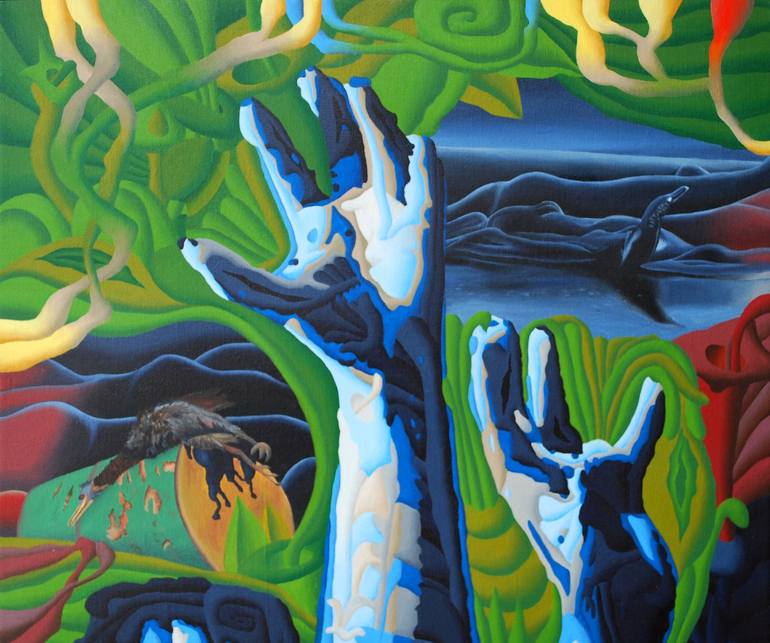


VIEW IN MY ROOM
Gulf of Mexico Oil Disaster Collage
Austria
Collage, other on Other
Size: 23.6 W x 19.7 H x 0.4 D in
About The Artwork
The oil catastrophe in the gulf of Mexico, a cruel pollution scene: dying birds, human hands reaching out for help. --------------------------------------------------------------------------------------------------------------------------------------------------------------------------------- Am 20. April 2010 explodierte die Ölbohrplattform „Deepwater Horizon“, die im Golf von Mexiko von der Firma Transocean im Auftrag des Konzerns BP betrieben wurde. Elf Menschen kamen dabei ums Leben und die Plattform sank zwei Tage später. Fast eine Million Tonnen Rohöl traten in der Folge aus dem Bohrloch aus, ehe am 16. Juli 2010 der Ölausfluss mit einem temporären Verschluss gestoppt werden konnte. Alle Maßnahmen wie Eingrenzung des Ölteppichs mit schwimmenden Barrieren, kontrolliertes Abbrennen und Dispersion des Öls mit Chemikalien zeigten nur begrenzte Wirkung und führten zum Teil zu neuen Problemen. Das Abbrennen erzeugte erhebliche Luftverschmutzungen und durch das Ausbringen von chemischen Substanzen wurde das Öl unter Wasser gedrückt, so dass Rückstände durch polycyclische aromatische Kohlenwasserstoffe über Plankton in die Nahrungskette gelangen. Obwohl die Berichterstattung aus dem Gebiet jetzt bei weitem nicht mehr so intensiv erfolgt, wie zu Beginn des Ereignisses, sind die Folgen auch heute noch gravierend. Ganze Seevögelkolonien, sowie Fisch- und Austernbestände wurden zerstört, Küstenvögel wie Braunpelikane, Rötelreiher, Seeregenpfeifer und Scherenschnäbel waren und sind dem Öl schutzlos ausgeliefert, Delfine und Meeresschildkröten sind bedroht und die Lebensgrundlage im Bereich der Tierschutzgebiete an der Mississippi-Mündung ist langfristig gestört. Das Bild „Die Ölkatastrophe von Mexiko“ von Werner Horvath setzt sich mit dem Problem auseinander. Man erkennt sich verzweifelt in die Luft reckende Hände – ein Symbol für die Leiden der Bevölkerung in diesem Gebiet, denn auch viele Menschen sind als Folge der Ölpest erkrankt. Am stärksten betroffen ist aber die Tierwelt, und auch dies ist auf dem vorliegenden Bild in eindrücklicher Form dargestellt. Es ist zu hoffen, dass sich solch ein Ereignis nicht wiederholt. Ähnliche Hoffnungen wurden aber auch schon nach dem Tankerunglück der Exxon Valdez in Alaska im Jahr 1989 geäußert, als man vom größten anzunehmenden Unfall dieser Art sprach. Und dann trat im Golf von Mexiko alle acht bis zehn Tage eine solche Supertankerladung aus und dies über Monate...
Details & Dimensions
Collage:other on Other
Original:One-of-a-kind Artwork
Size:23.6 W x 19.7 H x 0.4 D in
Frame:Not Framed
Ready to Hang:No
Shipping & Returns
Delivery Time:Typically 5-7 business days for domestic shipments, 10-14 business days for international shipments.
Have additional questions?
Please visit our help section or contact us.
Austria
Werner Horvath - now working in Vienna, Linz and on the island of Crete (Greec) - was born in Linz, Austria in 1949 and has been painting since his youth. Beside this interest he studied medicine in Vienna and was a well known chief radiologist in Linz, specialising in interventional radiology. Horvath decided to leave the medical profession at the age of 50 and has been working as a freelance artist ever since. He opened a studio named "Villa Arte" in Kastellos on the island of Crete (Greece)2003 and his "Atelier Horvath" in Linz, Austria, where he works during the winter. His artistic style was taken from Phantastic Realism in the early years to New Constructivism in the later and more modern times. The term "New Constructivism" is taken from the philosophical theory and based on the works of Vico, Uexkll, Glasersfeld and Watzlawick, to name a few. The theoretical background is explained in detail by the artist in a stage play in form of a text-collage, called Jahrtausendwende - Die Theorie des neuen bildenden Konstruktivismus (in German). Horvath had tried to portray in his paintings, the reality we rely on is not so real at all. The world that we live in is understood only as we construct it ourselves. For example, colours only exist in our consciousness, therefore are not "real". The same is for objects and relationships. Finally they take into consideration the fact that we live in a symbolic world. Not only do we view Stalin as a Russian politician but also a symbol of dictatorship and cruelty. Horvath uses current political events at the inspiration for his work and often the colours and shapes used help to portray his opinion on our society.
Thousands Of Five-Star Reviews
We deliver world-class customer service to all of our art buyers.
Global Selection
Explore an unparalleled artwork selection by artists from around the world.
Satisfaction Guaranteed
Our 14-day satisfaction guarantee allows you to buy with confidence.
Support An Artist With Every Purchase
We pay our artists more on every sale than other galleries.
Need More Help?